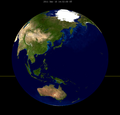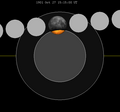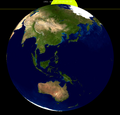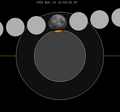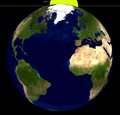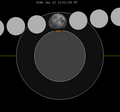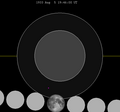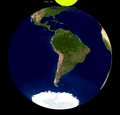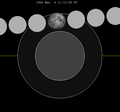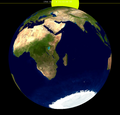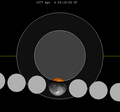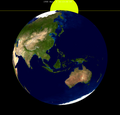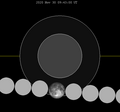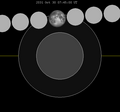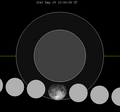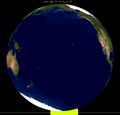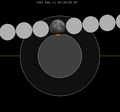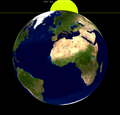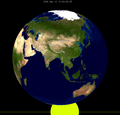December 2009 lunar eclipse
A partial lunar eclipse occurred at the Moon’s descending node of orbit on Thursday, December 31, 2009,[1] with an umbral magnitude of 0.0779. A lunar eclipse occurs when the Moon moves into the Earth's shadow, causing the Moon to be darkened. A partial lunar eclipse occurs when one part of the Moon is in the Earth's umbra, while the other part is in the Earth's penumbra. Unlike a solar eclipse, which can only be viewed from a relatively small area of the world, a lunar eclipse may be viewed from anywhere on the night side of Earth. Occurring only about 20 hours before perigee (on January 1, 2010, at 15:30 UTC), the Moon's apparent diameter was larger.[2] This eclipse was the last of four lunar eclipses in 2009, with the others occurring on February 9 (penumbral), July 7 (penumbral), and August 6 (penumbral). This lunar eclipse was also notable, because it occurred during a blue moon (a second full moon in December) and was near perigee (making it a supermoon). The next eclipse on New Year's Eve and blue moon will occur on December 31, 2028. Only a small portion of the Moon entered the Earth's umbral shadow, but there was a distinct darkening visible over the Moon's southern surface at greatest eclipse. VisibilityThe eclipse was completely visible over Europe, Asia, and much of Africa, seen rising over eastern North America and setting over Australia and the Pacific Ocean.[3]
Images Gallery
Eclipse detailsShown below is a table displaying details about this particular solar eclipse. It describes various parameters pertaining to this eclipse.[4]
Eclipse seasonThis eclipse is part of an eclipse season, a period, roughly every six months, when eclipses occur. Only two (or occasionally three) eclipse seasons occur each year, and each season lasts about 35 days and repeats just short of six months (173 days) later; thus two full eclipse seasons always occur each year. Either two or three eclipses happen each eclipse season. In the sequence below, each eclipse is separated by a fortnight.
Related eclipsesEclipses in 2009
Metonic
Tzolkinex
Half-Saros
Tritos
Lunar Saros 115
Inex
Triad
Lunar eclipses of 2009–2013This eclipse is a member of a semester series. An eclipse in a semester series of lunar eclipses repeats approximately every 177 days and 4 hours (a semester) at alternating nodes of the Moon's orbit.[5] The penumbral lunar eclipses on February 9, 2009 and August 6, 2009 occur in the previous lunar year eclipse set, and the lunar eclipses on April 25, 2013 (partial) and October 18, 2013 (penumbral) occur in the next lunar year eclipse set.
Saros 115This eclipse is a part of Saros series 115, repeating every 18 years, 11 days, and containing 72 events. The series started with a penumbral lunar eclipse on April 21, 1000. It contains partial eclipses from July 6, 1126 through September 30, 1270; total eclipses from October 11, 1288 through July 20, 1739; and a second set of partial eclipses from July 30, 1757 through February 13, 2082. The series ends at member 72 as a penumbral eclipse on June 13, 2280. The longest duration of totality was produced by member 36 at 99 minutes, 47 seconds on May 15, 1631. All eclipses in this series occur at the Moon’s descending node of orbit.[6]
Eclipses are tabulated in three columns; every third eclipse in the same column is one exeligmos apart, so they all cast shadows over approximately the same parts of the Earth.
Tritos seriesThis eclipse is a part of a tritos cycle, repeating at alternating nodes every 135 synodic months (≈ 3986.63 days, or 11 years minus 1 month). Their appearance and longitude are irregular due to a lack of synchronization with the anomalistic month (period of perigee), but groupings of 3 tritos cycles (≈ 33 years minus 3 months) come close (≈ 434.044 anomalistic months), so eclipses are similar in these groupings.
Inex seriesThis eclipse is a part of the long period inex cycle, repeating at alternating nodes, every 358 synodic months (≈ 10,571.95 days, or 29 years minus 20 days). Their appearance and longitude are irregular due to a lack of synchronization with the anomalistic month (period of perigee). However, groupings of 3 inex cycles (≈ 87 years minus 2 months) comes close (≈ 1,151.02 anomalistic months), so eclipses are similar in these groupings.
Half-Saros cycleA lunar eclipse will be preceded and followed by solar eclipses by 9 years and 5.5 days (a half saros).[8] This lunar eclipse is related to two partial solar eclipses of Solar Saros 122.
See also
References
External links
Wikimedia Commons has media related to Lunar eclipse of 2009 December 31. |
||||||||||||||||||||||||||||||||||||||||||||||||||||||||||||||||||||||||||||||||||||||||||||||||||||||||||||||||||||||||||||||||||||||||||||||||||||||||||||||||||||||||||||||||||||||||||||||||||||||||||||||||||||||||||||||||||||||||||||||||||||||||||||||||||||||||||||||||||||||||||||||||||||||||||||||||||||||||||||||||||||||||||||||||||||||||||||||||||||||||||||||||||||||||||||||||||||||||||||||||||||||||||||||||||||||||||||||||||||||||||||||||||||||||||||||||||||||||||||||||||||||||||||||||||||||||||||
Portal di Ensiklopedia Dunia

































